Introduction
Front
{{section_header}}{{section.name}}{{/section_header}}
The {{product.model}}'s freezer is on the top and the refrigerator is on the bottom. Cold air from the freezer falls into the fridge.
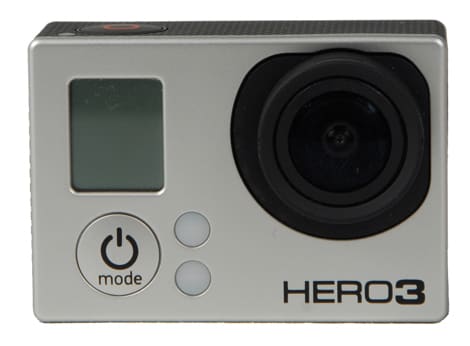
The stainless steel attracts fingerprints like a full fridge attracts college kids home on break.


Interior
{{section_header}}{{section.name}}{{/section_header}}
At the top of the refrigerator compartment is a large housing for vents, an incandescent bulb and a digital temperature adjuster.
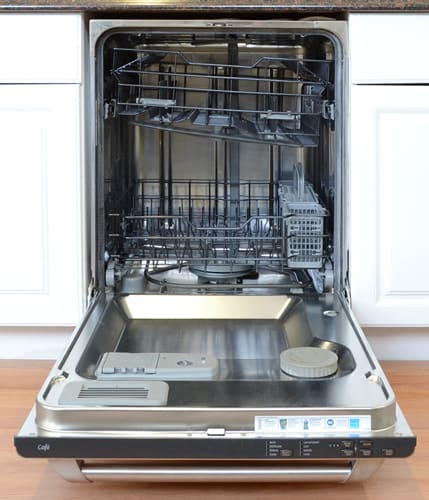
The interior of the CDWT980VSS.
The main cavity of the fridge features four shelves -- one adjustable full-width, two adjustable half-width and one fixed full-width shelf above the crisper drawers. One of the half-width shelves has a drawer hanging from it. The shelves are glass within a plastic bezel. Crisper drawers themselves have thick plastic handles, glide smoothly and don't tilt. Crisper adjusters are recessed and won't break.
The door features a reversible top half-shelf and dairy bin at the top, three adjustable half-shelves in the middle and one shallow fixed shelf at the bottom. All adjustable shelves fit snugly into place.
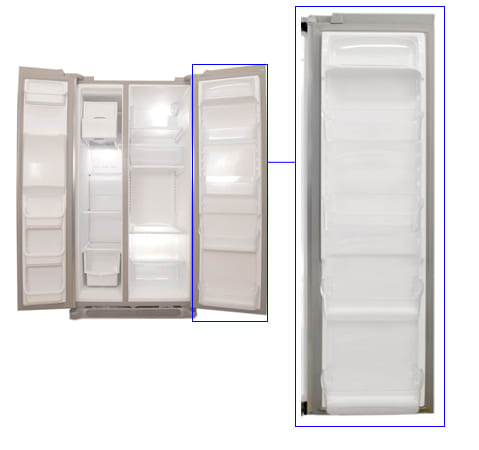
Inside the freezer, an adjustable full-width wire shelf separates the compartment into top and bottom. About a third half is taken up by the ice maker and bucket, the installation of which also precludes moving the shelf.
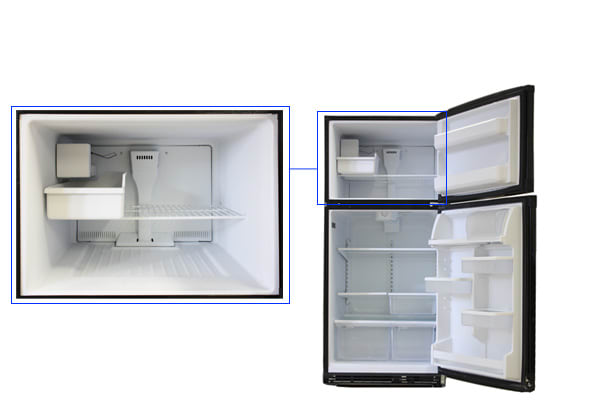
On the freezer door, two fixed, walled shelves can hold frozen vegetables or boxed frozen food.
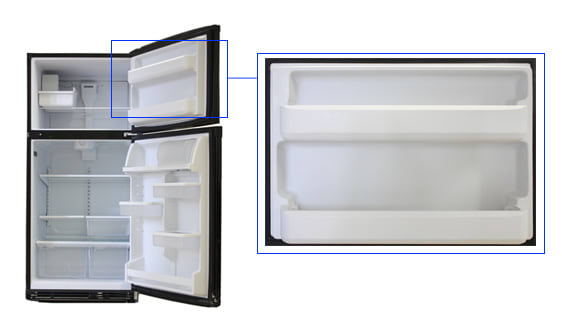
The ice maker and bucket take up about a third of the top half of the freezer compartment.
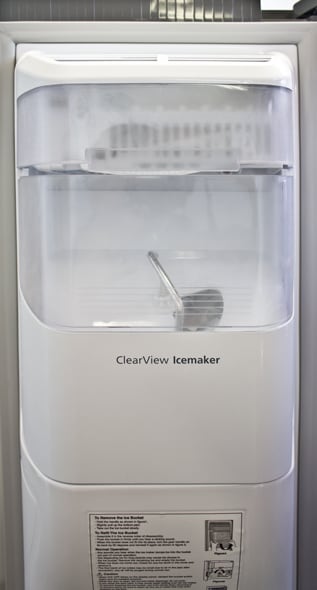
Back
{{section_header}}{{section.name}}{{/section_header}}
There's only a water hose on the back of this fridge.
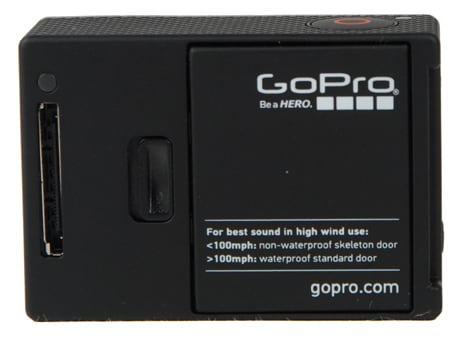
Sides
{{section_header}}{{section.name}}{{/section_header}}
The sides of the {{product.model}} are battleship gray.
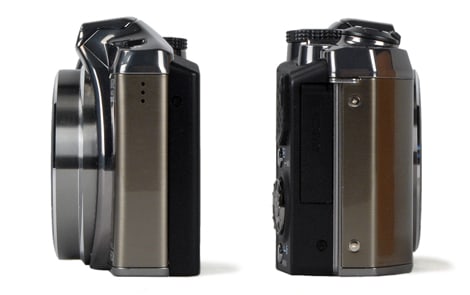
Olympus SZ-31MR iHS side views
Running Cost
{{section_header}}{{section.name}}{{/section_header}}
Assuming that electricity costs 9.1 cents per Kilowatt, the {{product.name}} will, on average, cost about $66 per year to run.
Power Use Per Cu Ft
{{section_header}}{{section.name}}{{/section_header}}
So we can compare fridges of different sizes, we also calculate power usage relative to the fridge's interior. The {{product.name}} is a little higher than comparable fridges, with a not-too-impressive score of 0.18 KWh per cubic foot.
Fridge Temperature
{{section_header}}{{section.name}}{{/section_header}}
A fridge's most basic function is keeping food cold without any major variations in temperature. To make sure that the {{product.name}} performed this most important task, we filled it with dummy food packages fitted with temperature sensors that measured variations in temperature over a period of several days.
The {{product.brand.name}} did a great job keeping a cool, even temperature, though we'd set it to run a little warmer than LG's recommended temperature setting.
Any fridge will have some spikes -- when the compressor first kicks on, or during a defrost cycle -- but this {{product.brand.name}} was a relative model of consistency.
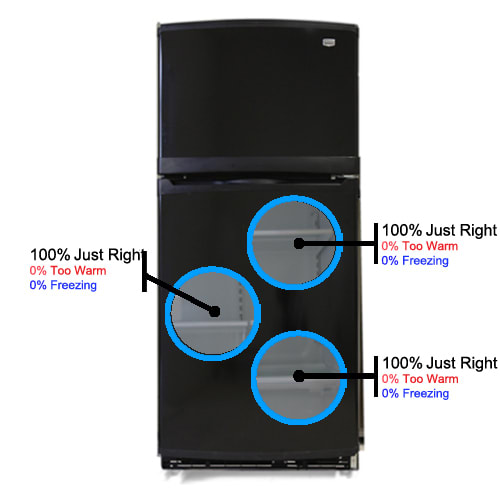
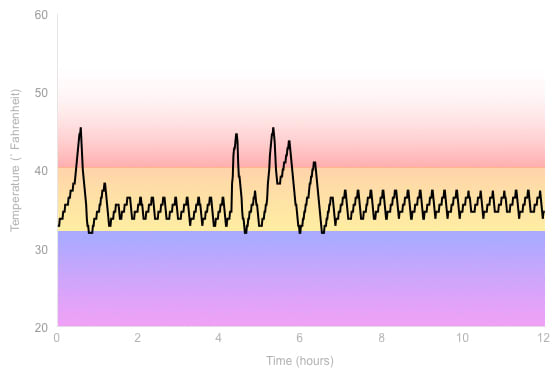
Freezer Temperature
{{section_header}}{{section.name}}{{/section_header}}
Consistency is even more important in a freezer compartment, as cycles of thawing and refreezing can cause freezer burn and ruin food. We searched for peaks and valleys in the {{product.name}} freezer's temperature readings by putting dummy frozen food packages fitted with temperature sensors in the freezer compartment, measuring the temperature every few minutes over the course of five days.
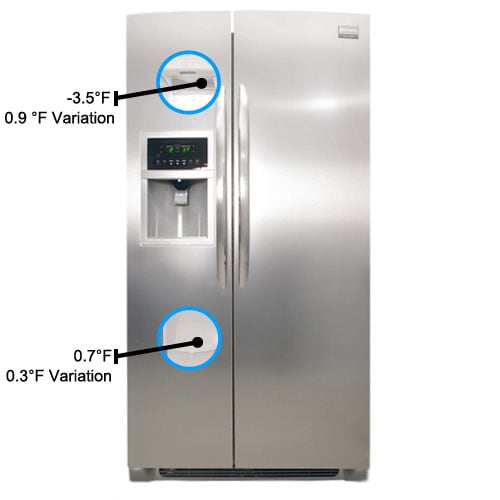
If you're a fan of mail-order frozen steaks, the {{product.name}} might be the fridge for you. Its freezer compartment was exemplary at holding a steady temperature over five days of tests, with only slight variations during defrost cycles. This consistency prevents freezer burn and spoilage.
Vegetable Drawer
{{section_header}}{{section.name}}{{/section_header}}
In order to keep fresh food from drying out from all the cold air blowing around inside a fridge, refrigerators have vegetable drawers that help fresh foods retain their humidity. We test the effectiveness of these drawers with a simulated vegetable: a piece of floral foam that has similar water-retaining properties as an actual veggie.
In the {{product.name}}, the simulated vegetable lost an average of 0.26 grams of water per hour over a four days. That's around average for a fridge in this price range, though it still means you should eat your vegetables within a few days. In a very high end fridge, veggies tend to lose fewer than 0.2 grams of water per hour.
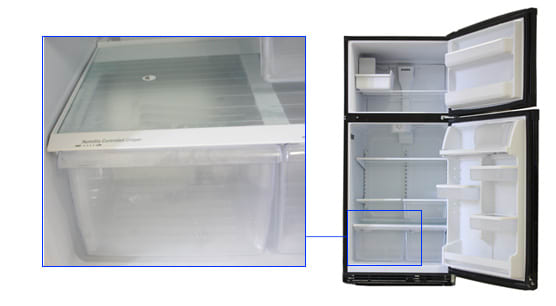
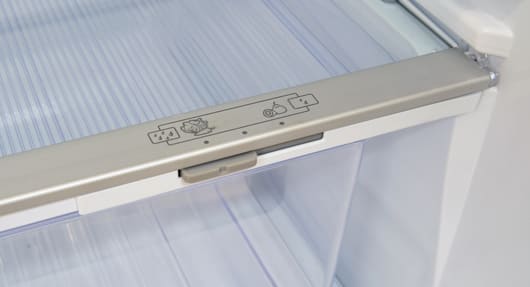
Power Loss
{{section_header}}{{section.name}}{{/section_header}}
A hurricane hits in the middle of August. Your family and property are OK, but the power is out and your freezer is full of ice cream. Will it still be cold when the lights come back on? That's why we test the ability of a freezer to hold in the cold when the power is turned off. It's also a good measure of the freezer's insulation, as a freezer that stays cold without power most likely won't lose cold air during normal operation.
The temperature in the {{product.name}}'s freezer stayed below 32 degrees Fahrenheit for more than 36 hours, meaning that the food inside didn't defrost. We're not recommending you dine on anything that may be spoiled, but chances are {{product.name}} owners' frozen foods will stay frozen as long as the power isn't out for more than a day and a half.
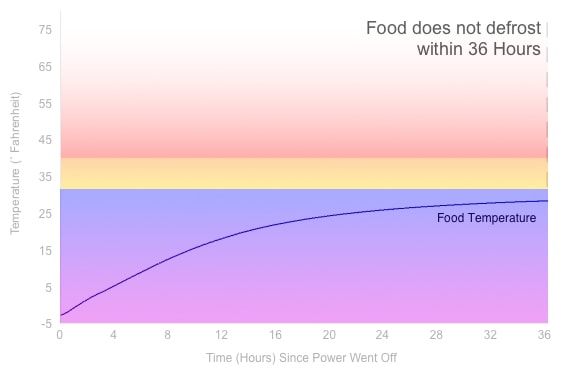
Freezing Performance
{{section_header}}{{section.name}}{{/section_header}}
To see how fast the {{product.name}} can freeze room-temperature foods, we put unfrozen dummy food packages with internal temperature sensors in the freezer compartment and checked to see how long it took for them to register 32 degrees Fahrenheit. The {{product.name}} will make your liquid Flavor-Ice solid in around 2 hours 15 minutes, which is slightly longer than some higher-end fridges.

Usable Space
{{section_header}}{{section.name}}{{/section_header}}
Inside the fridge there's one adjustable full-width shelf, two adjustable half-width shelves and one fixed full-width shelf over the dual crisper drawers. One of the half-width shelves features a small storage drawer. The fridge's large control console, however, eats up a lot of space from the top shelf.
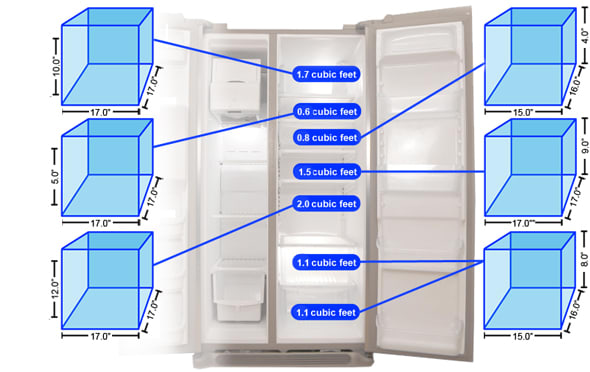
On the door are a swappable dairy bin and tray, three bins that can be moved up and down and a bottom shelf that's wide enough for two-liter soda bottles.
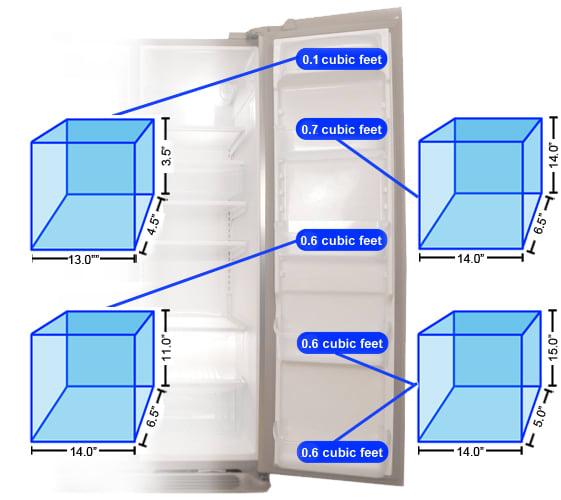
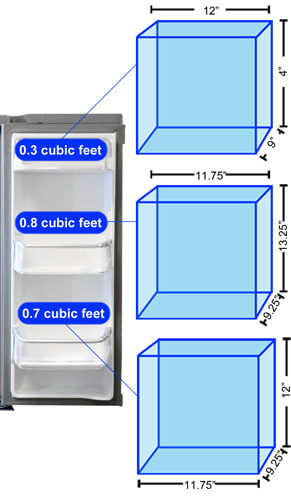
The freezer features one, large adjustable shelf that bisects the compartment widthwise. In theory, it's adjustable, but the icemaker and bin are so tall that it must be put in the lowest slot if you want ice, too.
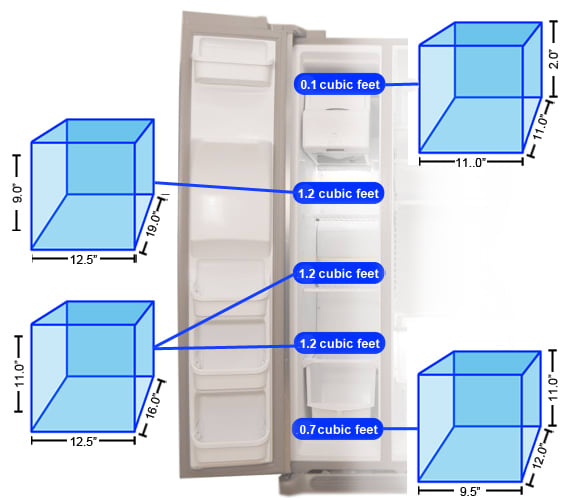
On the door, shelves aren't adjustable but they are removable, freeing up interior space for that big order from Omaha Steaks.
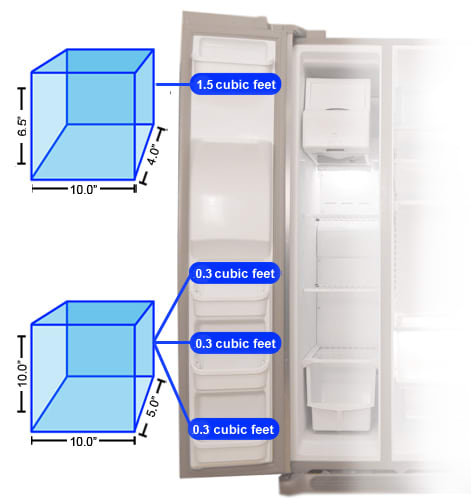
Below are the manufacturers own figures for capacity, and our own measurements for usable capacity. The manufacturers figures do not take account of the shelves, drawers and other removable features, but our measurements do account for the space these take up.
Ease of Access
{{section_header}}{{section.name}}{{/section_header}}
Though the {{product.model}}'s shelves hook, rather than slide, into place, they're lightweight enough that infrequent adjustments should not be a problem for most consumers.
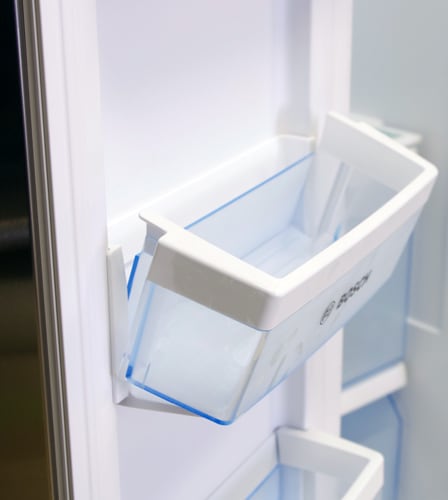
Controls
{{section_header}}{{section.name}}{{/section_header}}
A single digital display controls the temperature of the freezer and fridge. There's no temperature indicator, only a row of green LEDs with no corresponding scale.

Water Dispenser
{{section_header}}{{section.name}}{{/section_header}}

Ice Maker
{{section_header}}{{section.name}}{{/section_header}}
The ice maker and bucket take up about a third of the top half of the freezer compartment.

Cleaning
Noise
Other Features
{{section_header}}{{section.name}}{{/section_header}}
{{product.manufacturer_specs['Other Features Photo BROKEN?']}}
Specs
{{section_header}}{{section.name}}{{/section_header}}
As the {{product.name}} is larger than the Amana, there's more storage space.
Design
{{section_header}}{{section.name}}{{/section_header}}
On the outside and inside, the {{product.name}} is clearly a more refined fridge. The non-magnetic stainless exterior has a horizontal grain and looks brighter than the Amana's stainless finish. Inside, the fit and finish of the {{product.name}} is far superior, with drawers that are easier to open and shelves that are easier to adjust.
Performance
{{section_header}}{{section.name}}{{/section_header}}
The {{product.name}}'s temperature performance bests the Amana, with more consistent freezer and fridge temperatures. Combined with the energy efficiency numbers, we can imagine that the {{product.name}}'s compressor runs more often to keep temperatures even. The Amana does better at keeping the fresh foods in the vegetable drawer from drying out.
{{score_bars comp_num="1", scores="Power Use Rating, Running Cost Rating, Fridge Temperature Rating, Power Loss Rating, Freezer Temperature Rating, Freezing Test Rating"}}
Storage Space
{{section_header}}{{section.name}}{{/section_header}}
The {{product.name}}'s large control/lightbulb/vent panel in the fridge compartment takes up a lot of usable space on the top shelf, which is often reserved for taller items. That's a big minus. Still, it's got a bit more space than the Amana.
{{score_bars comp_num="1", scores="Freezer Usable Space Rating, Fridge Usable Space Rating"}}
Usability
{{section_header}}{{section.name}}{{/section_header}}
In addition to its far superior fit and finish, we find the {{product.name}}'s shelves easier to adjust and clean.
{{score_bars comp_num="1", scores="Usability Ease of Access Rating , Usability Controls Rating, Usability Water Rating, Usability Icemaker Rating, Usability Cleaning Rating"}}
Specs
{{section_header}}{{section.name}}{{/section_header}}
In a similar price bracket as the {{product.name}}, you can also buy a side-by-side fridge with through-the-door water and ice, plus more storage space.
Design
{{section_header}}{{section.name}}{{/section_header}}
The {{product.name}} is sleek and modern with a stainless front, while the Frigidaire has a more traditional textured white exterior. It's a matter of personal preference which you prefer.
Performance
{{section_header}}{{section.name}}{{/section_header}}
The Frigidaire's inconsistent temperature readings mean that it doesn't stand a chance against the {{product.name}}, with great freezing and refrigeration performance.
{{score_bars comp_num="2", scores="Power Use Rating, Running Cost Rating, Fridge Temperature Rating, Power Loss Rating, Freezer Temperature Rating, Freezing Test Rating"}}
Storage Space
{{section_header}}{{section.name}}{{/section_header}}
Whether you prefer the deep, wide shelves of a top-freezer or the easily accessed narrow shelves of a side-by-side, the Frigidaire still has more interior storage space.
{{score_bars comp_num="2", scores="Freezer Usable Space Rating, Fridge Usable Space Rating"}}
Usability
{{section_header}}{{section.name}}{{/section_header}}
Both fridges have adjustable shelves, but the {{product.name}}'s fit and finish is better than the Frigidaire's.
{{score_bars comp_num="2", scores="Usability Ease of Access Rating , Usability Controls Rating, Usability Water Rating, Usability Icemaker Rating, Usability Cleaning Rating"}}
Specs
{{section_header}}{{section.name}}{{/section_header}}
The side-by-side versus top-freezer debate is alive and well, but these specs don't like: The Whirlpool can hold more food than the {{product.name}}, and it also has through-the-door ice and water.
Design
{{section_header}}{{section.name}}{{/section_header}}
If you want the stainless look on a budget, get the {{product.name}}. Similar Whirlpools are available in stainless, too, but cost a lot more money.
Performance
{{section_header}}{{section.name}}{{/section_header}}
The {{product.name}} outperformed the Whirlpool at providing a consistent temperature in the freezer and fridge, but not by much.
{{score_bars comp_num="3", scores="Power Use Rating, Running Cost Rating, Fridge Temperature Rating, Power Loss Rating, Freezer Temperature Rating, Freezing Test Rating"}}
Storage Space
{{section_header}}{{section.name}}{{/section_header}}
With more volume, the Whirlpool has more storage space than the {{product.name}}. Still, some items won't fit in a narrow side-by-side.
{{score_bars comp_num="3", scores="Freezer Usable Space Rating, Fridge Usable Space Rating"}}
Usability
{{section_header}}{{section.name}}{{/section_header}}
The Whirlpool's slide-in shelves are always easier to adjust than the {{product.name}}'s hook-in shelves, but the {{product.name}} is easier to clean. It's a toss up!
{{score_bars comp_num="3", scores="Usability Ease of Access Rating , Usability Controls Rating, Usability Water Rating, Usability Icemaker Rating, Usability Cleaning Rating"}}
Conclusion
Energy Efficiency
The {{product.name}}'s one weak spot is energy efficiency. We suspect it comes at the expense of keeping the fridge at such an even temperature.
Performance
The temperatures inside the fridge and freezer are always right where they should be, showing minimal variation during our tests.
Storage Space
Though the vent/lightbulb/control combo takes up a lot of space in the fridge, there's still adequate storage space inside the {{product.name}}.
Usability
The {{product.name}} features excellent fit and finish for its class and price range. Drawers slide more uniformly and shelves are easier to adjust than in similar fridges, especially those built on Whirlpool's entry-level platform.
Meet the tester
Keith was the Editor in Chief of Reviewed's appliance and automotive sites. His work has appeared in publications such as Wired, Car & Driver, and CityLab.
Checking our work.
Our team is here to help you buy the best stuff and love what you own. Our writers, editors, and experts obsess over the products we cover to make sure you're confident and satisfied. Have a different opinion about something we recommend? Email us and we'll compare notes.
Shoot us an email